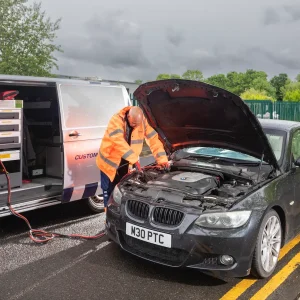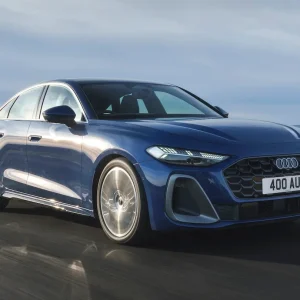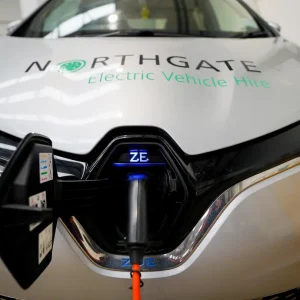“I want more visibility and prominence because we, as a big consumer of cars, vans and trucks, have a view and want it to be heard.”
So declares the new British Vehicle Rental and Leasing Association chief executive Gerry Keaney in one of his first interviews since taking over as head of the organisation in May from the prominent, influential and long-standing John Lewis, who stepped down after 13 years in the role.
Keaney himself is no stranger to the industry as a whole, or the sector, following 21 years with Volvo, including a six-year stint as UK boss until 2002 before moving to the firm’s Swedish headquarters, and says he has “enjoyed making the transition” since arriving back in the country.
“I knew the sector very well. I’ve clearly been very involved in the UK in my previous roles, then globally with relationships with leasing and daily rental sectors, and I know some if not all of the personalities,” he tells BusinessCar.
Having now been involved in a full round of meetings of the BVRLA’s various committees, Keaney is beginning to get his feet under the desk and understand the issues important to members.
“It’s good to see my perception from the outside has been borne out very well from working with the firms,” he continues, pinpointing the sector’s professionalism, customer focus, dialogue and creativity. “It’s a very dynamic sector, lots going on.
What is clear is that it’s a complicated environment, but that’s not to say our members aren’t rising to the challenge.”
One of Keaney’s first priorities is to increase the association’s volume, making sure the views of its members are expressed.
“It’s important we make our voices heard [with the Government] on the likes of road safety, green issues and taxation,” he says. “For example, it’s great news for the industry that there’s £1bn of extra investment in low-carbon vehicles and transport infrastructure and it’s important to have an understanding of the BVRLA views in these initiatives.”
He continues: “This has been an extremely successful organisation, there’s no doubt of that. What John Lewis has done with the team has been first rate and I’m fortunate to inherit a strong and stable organisation. There is an opportunity for us to continue the work behind the scenes. There is a good structure in place with policy and legal and now is the opportunity to move onto another level.”
Part of that is the commencement of a drive behind the scenes to improve the data analysis of the rental and leasing sector to illustrate its importance. “What has held us back is getting good data,” states Keaney, saying that a report commissioned by the association and written by Oxford Economics in May was a good start. It showed the UK car and van sector of the rental and leasing industry contributes around £14bn per year to the economy and supports more than 183,000 jobs.
“The report is a solid piece of work that lays down a platform as to how important the sector is and our members are to the growth of the UK economy, and it has given us background data on fleet numbers, but we need more data,” says Keaney. “I’d like to be able to say our segment has the ability to be a barometer – for example, if daily rental is up, what does that mean for UK PLC and the growth agenda?”
Keaney, though, is aware of the challenges that could be involved.
“We clearly have to be sensitive to members,” he says, revealing that the dialogue to see what data could be made available is only just opening up.
“There is lots of data out there that isn’t as trusted as ours,” he adds. “They want simple, efficient, trustworthy data and the most important thing is to launch something credible from day one.”
Government issues
There are other key issues for which Keaney will take up the baton and fight for members’ interests, striking a delicate balance between being vocal on behalf of the industry and ensuring a good dialogue behind the scenes with authorities.
“We clearly want to work with regulators in terms of getting the best and most appropriate solutions for members,” he says, using the example of the new lease accounting rules that will initially require some larger companies to show leased assets on their balance sheets. “At one level it’s inappropriate for our sector – it’s very hard to see how a single accounting standard can cover off nuclear power reactors at one end of the continuum to cars at the other.”
He feels vehicle leasing has been caught up in regulatory process without necessarily being the target. Therefore, his goal is to work with regulators to ensure any legislation is “implemented sensitively” to members’ needs. This is one example of where Keaney wants the BVRLA to be involved in the forging of regulations to help the rule-makers understand the implications, and have them implemented in the most efficient and appropriate way.
Meanwhile, he’s scathing of the Government’s decision to remove the first-year writing-down allowance for lease companies on vehicles under 95g/km. Outright-purchase fleets can still get that benefit of writing off 100% of the car’s value against tax in the first year, but that’s not the case for leasing firms. Keaney calls it a “fundamental mistake” and claims it will drive some fleets away from the lowest-emitting models. The association held a seminar late last month that was attended by representatives from the fleet sector, research organisations, manufacturers and authorities, with many stakeholders claiming the new legislation is already having an impact.
“There was a consensus that the taxation change was now an obstacle to selling low-emission vehicles,” claims Keaney, using a major accountancy firm’s example of a car previously classed as low emissions rising in lease rate by £20 per month to £274. “The likelihood would be that there are lots of other products you can get for £250 a month; unfortunately, they emit more CO2, but customers speak with their pocket.”
But the association can’t see any sign of a Government U-turn. “The team here have lobbied long and hard before the change and before the legislation, but it’s been passed now so it’s a fait accompli,” he comments. “There is no indication they have any propensity to go back on that. We understand that the Government has an affordability agenda and they are looking to make savings in every department.”
Despite the disappointment about first-year allowances, Keaney says the BVRLA and its members still have a vital role to play in the adoption of low-emission vehicles.
“We are in a unique position and if the right opportunity is there we can move incredibly quickly in driving the CO2 agenda,” he declares. “And it’s important to get electric and low-emission cars into the used market, with all the debate about RV and leasing cost. There is no clarity at the moment, so as soon as we establish a second market for EVs the sooner we can remove some of the mist.”
The BVRLA chief-executive expresses concern about the way Government incentives are being set up, questioning whether they will be enough to encourage uptake in their current form.
“We need to develop the consumer end, the cars need to be affordable and people need to buy,” he says, describing the benefit-in-kind concessions announced in chancellor George Osborne’s most recent Budget as “positive”, but he called for more “creativity” with the incentives, pointing to countries such as Norway, where electric vehicles are allowed to park for free in cities.
“What sort of whole-life incentive is there for the car – there’s nothing included at present allied to the whole-life cost,” he comments, calling for something “more credible than a crude discount up front” of £5000 when the vehicle is purchased.
“If I’m in the secondary market for this car then what does it mean for me? There is no confidence in what the RV of electric vehicles will be. A lot of work needs to be done in that arena.”
He speculated that a more creative approach to incentivising could include capital allowance incentives to help leasing companies.
“Not necessarily 100% capital allowance, maybe 80% or 90%, but not 50%,” Keaney suggests. He also criticises the Government’s £5000 grant for the purchase because it isn’t taken into account with company car benefit-in-kind, making a severe difference to driver’s bills from April 2016 when BIK bands begin to ramp up for low-emission vehicles.
The BRVLA’s new leader recognises that his new role as a figurehead for the industry will encompass many challenges.
“A lot is going on within the sector – it’s a very full agenda,” he reflects. “If you looked at the leasing sector, I’ve always been rather impressed with how they organise sales, how the big players run their business. It’s good to get on this side of the fence now, having been with a supplying company for 20 years.”
Leasing industry economics
The BVRLA commissioned a report, published in May, to help illustrate the importance of the sector.
Written by Oxford Economics, a commercial venture with Oxford University’s business college that provides economic forecasting and modelling for UK firms, the report found that the “full-service vehicle leasing and short-term rental sector” contributed almost £14.3bn in value added to the UK economy in 2011, across the operations of the industry itself, the purchase of UK-built vehicles and engines, car dealership activity and the impact on the used car market.
That equates to a pound in every £90 of UK GDP, or the combined economies of Bristol and Bath, and supports 184,000 jobs – one in 175 in the UK, generating almost £2.8bn in tax revenue.
Removing the indirect numbers, the full-service vehicle leasing and rental sector itself employs almost 38,000 people, contributing £8.3bn to UK GDP and adding £575m to the chancellor’s tax revenue.
The report also put out some detail on the number of vehicles operated by BVRLA members, who have 2.1 million of the 2.2 million leased vehicles on UK roads, emitting an average 123g/km in 2012. There are a further 270,000 hire vehicles to add to that from BVRLA members, of the 325,000 daily rental vehicles in total. And that’s without the half a million commercial vehicles also on members’ books.
A full copy of the report can be downloaded from www. oxfordeconomics.com/my-oxford/projects/232333.
The association’s key functions
Fighting the industry’s corner is seen by members as the key role of the BVRLA, according to its new chief executive Gerry Keaney.
“We are a member organisation and we have to represent the interests of our members,” he explains, pointing to an annual survey the association carries out, which details what the members value most.
“One is that they value the representation capacity of the association – we are representing the interests of the sector into Government and other outside bodies,” declares Keaney. “They want to feel we as an association are fighting for their interests, to see it and experience it. They want to see us punching above our weight.”
Next on the list is a “pride” in what being a member means, in terms of the mandatory codes of conduct it enforces.
“We have not set ourselves up as a regulator, but our codes have teeth, and if members don’t abide by them it’s quite possible they will leave the association,” Keaney declares.
The third of the three key benefits, according to Keaney, is that members value the products and services, consultation and advice on a daily basis on operational matters, specifically in areas such as legal issues and use of fair wear-and-tear guidelines, and conciliatory services.





